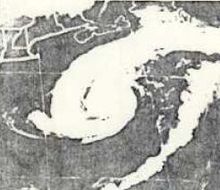 Tropical Storm Amy at peak intensity on July 2 | |
| Meteorological history | |
|---|---|
| Formed | June 27, 1975 |
| Dissipated | July 4, 1975 |
| Tropical storm | |
| 1-minute sustained (SSHWS/NWS) | |
| Highest winds | 70 mph (110 km/h) |
| Lowest pressure | 981 mbar (hPa); 28.97 inHg |
| Overall effects | |
| Fatalities | 1 direct |
| Damage | Minimal |
| Areas affected | Florida, South Carolina, North Carolina, Virginia and New Jersey |
| IBTrACS | |
Part of the 1975 Atlantic hurricane season | |
Tropical Storm Amy was the first tropical cyclone to develop during the 1975 Atlantic hurricane season. Forming on June 28 from a trough of low pressure, Amy gradually attained tropical storm status off the coast of North Carolina. A rapidly approaching trough caused Amy to turn sharply eastward before the storm took a general northeastward track. On July 2, the storm reached its peak intensity with winds of 70 mph (110 km/h) and a barometric pressure of 981 mbar (hPa; 28.97 inHg). During most of the storm's existence, Amy featured many subtropical characteristics but was not classified as such due to the proximity to land. By July 4, the system moved southeast of Newfoundland before becoming extratropical.
The main effects from Amy were rough seas, reaching up to 15 ft (4.6 m) in height, that were felt from North Carolina to New Jersey, inflicting minor coastal flooding and beach erosion. On June 30, a schooner carrying four people capsized off the North Carolina coastline, resulting in the death of the father of the other three crew members. They remained at sea for roughly 15 days before being rescued by a Greek merchant ship.